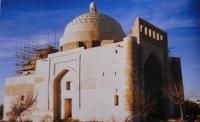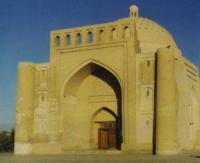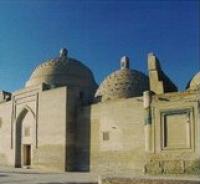You are here
Mausoleum of Sheikh Safe ad-Din Boharzi.



Go for a ride to Bukhara.
“In my monument, gouge a small hole on the top of the head so that the birds fly in there to drink”
Jules Renard.
Bus tours to the sights of Bukhara.
Sheikh Seif ad-Din Bokharzi (1190 - 1261) was a student of the outstanding Khorezmian Sufi Nadj ad-Din Kubro (died 1220), preaching in Bukhara, where he founded the famous khanaka followers of the Sufi Kubroviya movement. In Bukhara, Sheikh Boharzi succeeded in converting the Golden Horde khan Burke to Islam.
In the middle of the XIII century, he headed the Bukhara madrasah, founded by the Mongolian dignitary of Muslim Ma'skd bek. The Sufi khanaka in Fathabad was formed at the beginning of the 13th century, some time later, apparently, after the formation of the brotherhood (tariq) of Kubraviy in Khorezm, founded by Najm ad-Din al-Kubra. Kubraviya represented the Central Asian school of mysticism, was traditionally Sunni, extended its activities right up to the borders of western China and operated until the XVIIIth century.
Saif ad-Din Boharzi was the Murid (disciple) of Najm ad-Din Kubra, his follower and disseminator of the ideas of al-Kubra. In the khanaq they practiced quiet and loud zikr, chants themselves, preaching the ideas of al-Kubra - ritual purity, fasting, silence, withdrawal from the world, mental remembrance of God.
As in Tariq Kubraviy, in the Fathabad community, the power of the chief sheikh (caliph) was hereditary, all the descendants of Sayf al-Din Boharzi were sheikhs, who were at the head of the monastery in Fathabad.
The mausoleum attracts attention with the grandeur of its forms, the scale of its construction, the exceptional simplicity and clarity of the architectural idea. This is a more complex building - with a tomb - purkhana and a room of remembrance - ziarathona.
Two domes above them form the profile of the building. The mausoleum is almost devoid of decor, but it is more than covered by the richest decorative elements of the monument - a luxurious tombstone standing in the gurkhan's room.
This tombstone with amazing subtlety and multiplicity of pattern, boundless intricacy of the plexus of vegetative ornament and the most complex script of Arabic inscriptions is a true masterpiece of medieval wood carving.
After death, the sheikh was buried in Bukhara in the Fatkhabad area. At the end of the XIIIth century, a mausoleum was built over his grave, to which, in the XIVth century, the khanaka dome building with a portal was attached.
This khanaka was a place of Sufi radiations until the end of the XVIII century.
Enlightener:
Pugachenkova G.A., V.G. Saakov “History of Bukhara”. Shark Publishing House, 1996. “Bukhara.
Photos by
Alexey Arapov.







